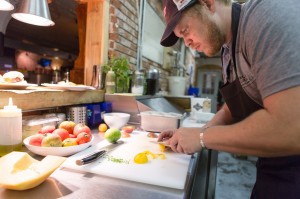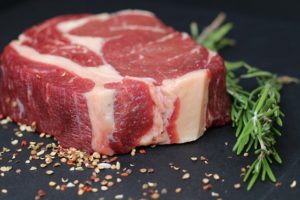 As promised a couple of weeks ago, we want to follow up on our coaching tip regarding the Maillard reaction and provide some guidance on…
As promised a couple of weeks ago, we want to follow up on our coaching tip regarding the Maillard reaction and provide some guidance on…
…how to cook the perfect steak!
With Valentine’s Day just one week away, you may be trying to decide on “the perfect meal” for your sweetheart. What could be better than a juicy, delicious steak, combined with some caramelized roasted vegetables and a luscious red wine?!
But, let’s be honest, cooking steak can be intimidating. It can feel like a lot of pressure to cook the perfect steak, especially for a special occasion like Valentine’s Day. Well, we have some tips to help you win the heart of that special someone, or to enjoy a delicious steak any day of the week!
Quality matters!
 The first key step is to choose quality meat. The key is the marbling, which you can see as flecks or streaks of fat that occur naturally within the muscle of the meat. With steaks, fat equals flavor, so you want to find a well-marbled piece of meat.
The first key step is to choose quality meat. The key is the marbling, which you can see as flecks or streaks of fat that occur naturally within the muscle of the meat. With steaks, fat equals flavor, so you want to find a well-marbled piece of meat.- It’s best to choose steaks that are 1″ to 1.5″ inches thick. This allows you to get the perfect crust on the outside without overcooking the inside.
- How the animals are fed and raised will also affect the flavor of the meat. This is all about personal preference. We enjoy the nutritional benefits that come from grass-fed and finished beef and enjoy buying from local producers who have a passion for their animals and meat.
- A couple of the most flavorful cuts are the ribeye and the strip steak — with good marbling, of course. Don’t be afraid that marbling is bad for your heart…just keep your portions “moderate,” around 4 to 6 ounces, and pair it with a variety of vegetables (not just potatoes) and a salad. Remember, balance is key!
Once you have found the perfect steak, in the perfect size, you are now ready to cook!
Room temperature is best. It is best to set your steak out at room temperature for 30 minutes to one hour before cooking. Otherwise, the heat will have difficulty efficiently penetrating to the middle of the steak. This will make it difficult to achieve the caramelized crust and perfectly-cooked center you are looking for.
Trim the fat? If you have selected a steak with quite a bit of fat, you can trim some off, but you want to leave about 1/4″ of fat on the steak for flavor and to help it cook evenly.
Simple Seasoning! There are different opinions on when to season the steaks, but the best bets are to do it either 45 minutes before cooking (allowing enough time for the liquids to be reabsorbed) or immediately before cooking. To season your steak:
- Pat it dry with a paper towel.
- Then brush oil on both sides.
- Season liberally with freshly ground salt and pepper. Or, feel free to add a rub of dried herbs such as garlic, thyme and rosemary. See our quick tips for a delicious Garlic Herb Steak Rub!
It’s no surprise there is more than one way to prepare a great steak. While grilling steaks is very popular, you can actually achieve even better results indoors.
Pan Sear Method:
this method is the quickest, and probably most common.
 Start with a very hot pan (a cast iron skillet works great) because this will help sear the meat and get the great flavors and aromas from the Maillard reaction.
Start with a very hot pan (a cast iron skillet works great) because this will help sear the meat and get the great flavors and aromas from the Maillard reaction.- If you did not brush oil on your steaks, you can add 1-2 Tbsp of oil to the pan. Just be prepared for a lot of smoke.
- Add the seasoned steak to the skillet and sear it for a couple minutes on each side. Continue to flip the steak every couple minutes until is reaches the desired temperature. (Use a thermometer and reference the temperatures below).
- Let the steak rest for 5 minutes before serving.
Pan to Oven Method:
 this approach is just like it sounds.
this approach is just like it sounds.
- Start with the pan sear method to sear a browned crust on each side of the steak, for about 2-5 minutes per side.
- Then transfer the steak to a 350 to 400 degree oven to finish cooking for 5-15 minutes until it reaches the desired temperature.
- Let the steak rest 5 minutes before serving.
Reverse Sear Method:
 you are probably catching on by now…this method starts in the oven and ends with the pan sear. This method can be a good choice for thicker pieces of meat. It takes the longest and, for accuracy, a meat thermometer is recommended.
you are probably catching on by now…this method starts in the oven and ends with the pan sear. This method can be a good choice for thicker pieces of meat. It takes the longest and, for accuracy, a meat thermometer is recommended.
- Place the seasoned steak in a 275 degree oven on a baking sheet (and wired rack if desired) and cook about 45-60 minutes, until it reaches a temperature of 125 – 135 degrees F.
- Remove the steak from the oven and let it rest about 10 minutes.
- Then, sear the steak in a very hot skillet for one minute on each side and serve it immediately.
Get your grill on!
 Of course, you can also get great results on the grill.
Of course, you can also get great results on the grill.
- Bring your steak to room temperature and season it. You can also brush the grill with oil to help keep your steak from sticking.
- Similar to the pan sear method, the key is to grill the steak on a high temperature for a short amount of time. After grilling each side on high heat for 3 minutes or so, move the steak to a less intense heat until it reaches the desired temperature.
- Let the steak rest 5 minutes before serving.
Curb the urge! Resist the urge to cut into the steak to see if it’s done…you will lose valuable juices and flavor.
So, how do you know when your steak is done?
Some people can tell by feel. A rare steak will feel soft and spongy, medium-rare will have a springy firmness and medium will be less springy. For those who haven’t mastered the feel, a meat thermometer can come in very handy.
- Rare steaks: aim for 125 degrees F
- Medium rare: 130 degrees F
- Medium: 140 degrees F
- Medium well: 150 degrees F
- Well done: 160 degrees F
 It is also useful to know that you should stop cooking the steak when it is 5 degrees below your desired temperature — it will continue to cook while it “rests.”
It is also useful to know that you should stop cooking the steak when it is 5 degrees below your desired temperature — it will continue to cook while it “rests.”
Let it rest. Although many of us are anxious to dive in and enjoy, be patient and let your steak rest for 5 minutes! This allows the juices to reabsorb and evenly distribute back into the meat, meaning the juices will be in the meat, not running out all over your plate when you cut into it. For added flavor, you can also rub it with olive oil and chopped fresh herbs, such as basil, thyme or rosemary, just before resting.
So, what do the experts think is the best way to cook a steak?
We consulted a couple of local experts for even more great tips and advice!
 Chef Josh Rathbun, from Wichita’s Siena Tuscan Steakhouse, says the most important element of a great steak is the quality of meat. In a perfect world, he would choose meat from a unique heritage breed, Highland cattle. Because their long, shaggy fur keeps them warm, their fat is stored directly in the muscle, resulting in a delicious, flavorful and tender cut of meat.
Chef Josh Rathbun, from Wichita’s Siena Tuscan Steakhouse, says the most important element of a great steak is the quality of meat. In a perfect world, he would choose meat from a unique heritage breed, Highland cattle. Because their long, shaggy fur keeps them warm, their fat is stored directly in the muscle, resulting in a delicious, flavorful and tender cut of meat.
Chef Josh starts by bringing the steak to room temperature on a plate covered with plastic wrap for about one hour. Then, he rubs the steak with oil and heavily seasons it with salt and pepper. He adds grapeseed oil to a skillet over high heat, and then sears the steak on both sides. Then, he pours the oil out of the pan and lowers the heat. With the steak still in the pan, he adds butter, crushed garlic, chopped shallot, fresh thyme and rosemary. When the butter has melted, he uses a spoon to baste the steak with the butter/garlic/herb mixture. He then lets the steak rest for 5 minutes on a wire rack. And, the result? Absolutely delicious!
 Chef Travis Russell, at Wichita’s Public at the Brickyard, prefers cooking his steaks on a “rippin’ hot” charcoal grill. While he fires up the grill, he lets the steak sit out at room temperature for about 30 minutes. Before cooking, he pats it dry and seasons it with a dry mix of salt, pepper, garlic and dried ground mushrooms. He then sears the steak on both sides so it is charred on the outside, while staying juicy and medium rare on the inside. At home, Chef Travis admits he prefers Pittsburgh-style on the grill, searing the outside and leaving the center rare. He says the trick to great grill marks is to sear it 1-2 minutes, rotate 1/4 of a turn, and sear another 2 minutes. Then, flip and sear the other side for 3-4 minutes. Finally, let it rest on a cutting board, covering it loosely with foil if desired. The end result is perfection!
Chef Travis Russell, at Wichita’s Public at the Brickyard, prefers cooking his steaks on a “rippin’ hot” charcoal grill. While he fires up the grill, he lets the steak sit out at room temperature for about 30 minutes. Before cooking, he pats it dry and seasons it with a dry mix of salt, pepper, garlic and dried ground mushrooms. He then sears the steak on both sides so it is charred on the outside, while staying juicy and medium rare on the inside. At home, Chef Travis admits he prefers Pittsburgh-style on the grill, searing the outside and leaving the center rare. He says the trick to great grill marks is to sear it 1-2 minutes, rotate 1/4 of a turn, and sear another 2 minutes. Then, flip and sear the other side for 3-4 minutes. Finally, let it rest on a cutting board, covering it loosely with foil if desired. The end result is perfection!
 The fun is experimenting with different types of meat and different cooking methods. Remember to enjoy that juicy delicious steak with plenty of veggies — a great recipe to try…Strip Steak Over Shaved Brussels Sprouts!
The fun is experimenting with different types of meat and different cooking methods. Remember to enjoy that juicy delicious steak with plenty of veggies — a great recipe to try…Strip Steak Over Shaved Brussels Sprouts!
Bon appetit!



Great stuff, who doesn’t love a great steak! I agree w/ everything except for the temperatures. I traditionally allow for carryover cooking while letting it rest. By that I mean if I want a MR steak I will pull it at 120 degrees. As it rest or sets up it will continue to cook. I usually let it rest for 10-15 minutes. By the time you cut into it a perfect Medium Rare.
If you ever get to Washington DC, look up Chef Paul at the Hyatt Crystal City and enjoy one of his steaks, or one of his wonderful creations using fresh, local, in-season ingredients…you won’t regret it!